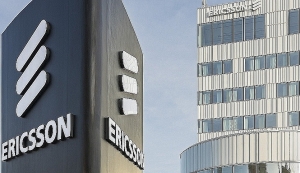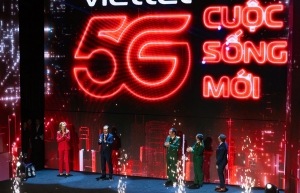Rising use of Generative AI Apps boosts consumer interest in differentiated connectivity
With the number of smartphone owners who use GenAI apps on at least a weekly basis expected to increase 2.5-fold in the next five years, the rapidly growing category joins existing differentiated connectivity use cases such as video calling, streaming, and online payments that smartphone users say they are willing to pay a premium for.
 |
| Photo: Ericsson |
Differentiated connectivity and consumers’ willingness to pay communications service providers (CSPs) for the guaranteed higher performance for essential apps is the subject of the latest global report from Ericsson ConsumerLab, called "Elevating 5G with Differentiated Connectivity".
Almost one-in-four GenAI users say they are already willing to pay up to 35 per cent more for guaranteed fast and secure connectivity for high-capacity applications.
The research shows that 35 per cent of 5G smartphone users surveyed say they would be interested in paying for differentiated connectivity for essential applications.
The CSP-focused report also addresses revenue generation opportunities for service providers based on the survey.
 |
| Photo: Ericsson |
Jasmeet Sethi, head of ConsumerLab, said, “The latest comprehensive Ericsson ConsumerLab research indicates that as AI-powered applications become more prevalent, users’ expectations for enhanced connectivity are rising. This reflects consumers' expectations for AI apps' future capabilities, perhaps relating to image, audio or video generation, and their willingness to pay for those capabilities to perform in a speedy and high-quality way. This signals an opportunity for CSPs globally to meet this demand through tailored connectivity experiences.”
Sethi added the differentiated connectivity revenue generation potential for CSPs will increase as they transition to performance-based business models, offering tailored subscriptions and plans with assured performance for different consumer segments in the market.
 |
| Photo: Ericsson |
“This shift could drive a 5-12 per cent uplift in 5G average revenue per user as people seek guaranteed reliable performance for specific applications,” he said. “Additionally, there is an opportunity to unlock new revenue pools from the significant demand among 5G users for high-performance apps, with one in three 5G smartphone users willing to reallocate 10 per cent of their current mobile app spend to purchase apps with in-built elevated connectivity. “
Rita Mokbel, president and CEO of Ericsson Vietnam stated,” Once the 5G networks in Vietnam are fully deployed, CSPs in Vietnam can expose quality-on-demand network APIs to developers and can thereby tap into the consumer demand for high-performance apps. They can thus enable developers to offer premium, high-performance experiences and unlock new revenue streams in the process. This is one example of network API CSPs can expose.”
| Key research takeaways Assurance seekers’ segment: Contrary to the belief that users will not pay extra for connectivity, the survey identified 20 per cent of users, known as ‘assurance seekers’, actively seeking elevated connectivity for critical applications they are willing to pay for. Generative AI app demand: The number of smartphone users using GenAI apps weekly is expected to rise 2.5-fold in the next five years. One in four current AI users are already willing to pay 35 per cent more for differentiated connectivity to ensure fast and responsive performance of AI-driven apps. Regional interest: Markets such as India, Thailand, and Saudi Arabia have doubled the share of smartphone users interested in differentiated connectivity compared to markets such as France and Spain. Five-stage journey for CSPs: The study outlines a pathway for CSPs from non-differentiated mobile broadband to performance-driven and platform-based models, where network APIs empower developers to create customised app experiences. More than 23,000 smartphone users between the ages of 15 and 69 were surveyed online for the research, and more than 17,000 were 5G smartphone users from 16 key markets with a global spread. Ericsson researchers say the survey is representative of 1.1 billion people, including 750 million 5G smartphone users. Surveyed 5G users came from Australia, Brazil, Canada, Mainland China, France, Hong Kong, India, Saudi Arabia, Singapore, South Korea, Spain, Taiwan, Thailand, UAE, the United Kingdom, and the United States. |
 | Ericsson launches project to develop young telecom talent Ericsson, a global leader in telecommunications, on October 8 announced the launch of the EricssonEdge Academia Programme that aims to revolutionise early career talent development in the telecommunications sector across Southeast Asia, Oceania, and India. |
 | Ericsson and VNPT collaborate on 5G in Vietnam Ericsson and VNPT, one of Vietnam's leading telecommunications operators, officially announced on October 10 their partnership to deploy 5G technology. |
 | Viettel extends Ericsson partnership through major 5G network award Viettel has strengthened its long-term partnership with Ericsson through the award of the majority of its nationwide 5G Radio Access Network (RAN) deployment. |
What the stars mean:
★ Poor ★ ★ Promising ★★★ Good ★★★★ Very good ★★★★★ Exceptional
Themes: Digital Transformation
Latest News
More News
- Legal framework completed for national digital transformation (December 13, 2025 | 21:55)
- How smart infrastructure and digitalisation power the systemic transition (December 11, 2025 | 10:00)
- Lawmakers split over VAT on fertilisers and animal feed (December 10, 2025 | 18:56)
- Kim Long deal marks turning point for Vietnam’s auto industry (December 10, 2025 | 18:44)
- Pernod Ricard Vietnam supports flood-hit localities (December 10, 2025 | 14:18)
- SABECO honoured at Vietnam M&A Forum for outstanding deal of 2024-2025 (December 10, 2025 | 12:00)
- Vietnam raises taxable revenue threshold for household businesses to VND500 million (December 10, 2025 | 11:34)
- Vietnam M&A Forum 2025: new position, new momentum (December 09, 2025 | 14:30)
- Masan Consumer reveals HSX listing roadmap (December 09, 2025 | 14:09)
- Industrial sector posts robust gains as year-end demand rises (December 09, 2025 | 13:38)






















 Mobile Version
Mobile Version